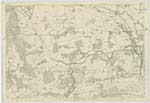OS1/1/51/31
| List of names as written | Various modes of spelling | Authorities for spelling | Situation | Description remarks |
|---|---|---|---|---|
| CAMIES' STONE | Camus Stone Camies' Stone Camies' Stone Camies' Stone Camiestane |
The Sculptured Stones of Scotland 1856 Mr G. Cruickshank Mr J. Christie Mr Alexander Watt Kintore New Statistical Account page 659 |
054 | An upright stone, four feet high, and 18 inches square at the base, which is traditionally said to mark the spot where a Danish General named Camus or Cambus was slain at some remote period. The site of the battle in which Camus was Killed cannot be pointed out, and from the following extract taken from a work belonging to the Spalding Antiquarian Club, entitled "The Sculptured Stones of Scotland, 1856." it would appear doubtful if ever such an engagement took place,or, that such an individual as Camus, as a Danish leader, ever existed. |
Continued entries/extra info
[Page] 31Aberdeenshire Parish of Kintore
"This Represents the Cross at Camuston
near Panmure, and is popularly supposed to mark the spot where Camus, said to have been the Commander
of the Danes, fell, on his retreat from the Battle of Barry. This supposition has gained credit, from the circumstance
of a stone coffin having been found near the place, about the beginning of the seventeenth century,
containing a skeleton of large size, of which the skull seemed to have been cut away by the stroke of a sword.
The following is Commissary Maule's descriptionof it, as given in Gordon's "Hinerarium", the only authority
in which any account of it is known to exist:- "About eight miles from Brechin, at Karbodds, a place
belonging to the Earl of Crawford, is to be seen the vestiges of a Danish Camp, fortified with a rampart and
ditch, and vulgarly called Norway Dikes; near which is the village of Panbride, where was anciently a church,
dedicated to St Brigide, because, on that Saint's day, which preceded the battle, Camus, General of the
Danes, pitched his camp there. Not far from whence is the Village of Barry, where a mighty battle was
fought between the Danes and Scots, with great slaughter on both sides, near the mouth of a small
rivulet called Loch Tay. There, many little artificial mounts, or tumuli, are still to be seen, within which
were buried the bodies of those slain in the fight; and because the soil thereabouts is sandy, the wind
blowing away the sand, frequently discovers bones of a size much exceeding men of our age. Near
this is Camus Town, a village belonging to the Barons of Panmure, and noted for the death of Camus"
[Continued page 32]
Transcribers who have contributed to this page.
Kate51- Moderator, John Jessiman
Location information for this page.
Linked mapsheets.




